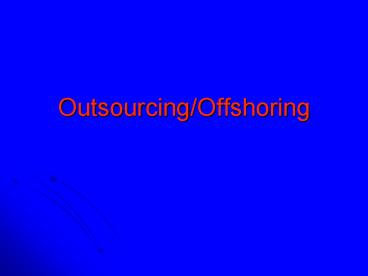Outsourcing/Offshoring - PowerPoint PPT Presentation
Title:
Outsourcing/Offshoring
Description:
Organizational: enhance effectiveness, improve flexibility, increase ... workforce in industrialized world will be in full-time jobs in the 21st century... – PowerPoint PPT presentation
Number of Views:37
Avg rating:3.0/5.0
Title: Outsourcing/Offshoring
1
Outsourcing/Offshoring
2
Outsourcing
- Act of transferring some recurring internal
activities to outside providers, set in a
contract - Reasons / Benefits
- Organizational enhance effectiveness, improve
flexibility, increase product/service value - Improvement improve performance, obtain
expertise, improve control, acquire ideas,
improve credibility - Financial free up resources, generate cash
- Revenue gain market access, sped expansion,
expand sales - Cost Reduce costs
- Employee expand career path,
3
Levels of Outsourcing
- Individual, Functional, Process
- Individual moving specific positions out
- Functional moving functions out
- Processes particular tasks moved out
4
Strategic Outsourcing
- When outsourcing is aligned with firms long-term
strategies, benefits may take years, and
examines - Future vision
- Core competencies
- Structure
- Costs
- Performance
- Competitive advantages
- ALL outsourcing should be strategic
5
History
- Farmers have used migrant workers
- Construction Cos. Subcontract
- Govt. subcontracts military equipment
- Outsourcing transfers internal activities
- Now, functions ex payroll, IS/IT, Acct,
Facilities management, janitorial, Food - Processes are not commonly outsourced
6
Outsourcing Trends
- Handy (London Bus Sch) less than half workforce
in industrialized world will be in full-time jobs
in the 21st century... - He describes shamrock org, where leaves of
shamrock are - Professional core workers
- Nonessential work contracted out (cheaper)
- Flexible labor force (P-T , temp workers)
- Customer doing the work
- Instead of 1-2 firms people work for 5-10 women
entered workforce firms downsize
7
Outsourcing Trends
- Large firms not competitive advantage
- Small, agile niche firms change structure, cost
overnight - Global economy creates more competitive pressure
- Product, service cycle times dramatically reduced
- Significant operating, financial performance
critical to success - Technical specialists available no need to hire
them internally - Cutting edge technology, knowledge now considered
competitive weapons expensive
8
Outsourcing Trends
- Outsourcing used when internal incompetence
caused failure now used to restructure
successful orgs - Larger orgs outsource entire processes
- Processes furthest from the core first, moving
toward it - Unlikely that operating processes, management
positions will be outsourced - Outsource global functions, processes to firms
with global presence, expertise - Smaller firms growing outsourcing individual
tasks (rent a CFO, CIO)
9
Outsourcing Growth
- Double digit growth expected in decade
- In 2000, market was 282 billion (20 growth)
- Outsource providers increased 65 1989-1994
- 1960s, internal audit accepted by acct firms
- Now outsourcing services means seeking audit
business
10
Seven Steps to Successful Outsourcing
- Greaver
11
One
- Assess risks
- Announce initiative
- Form project team
- Engage advisers
- Train the team
- Acquire other resources
- Address issues
- Resource management
- Information management
- Project management
- Set objectives
12
Two
- Understand Organizations vision
- Vision
- Core competencies
- Structure
- Transformation tools
- Value chain
- Strategies
- Determine
- Decision rights
- Contract length
- Termination date
- Align Initiative
13
Three
- Measure activity costs
- Project future costs
- Measure performance
- Existing and future
- Cost of poor performance
- Benchmark costs/ performance
- Determine
- Specific risks
- Asset values
- "Make" total costs
- Pricing models
- Final targets
14
Four
- Set qualifications
- Set evaluation criteria
- Identify providers
- Screen providers
- Draft RFP
- Evaluate proposals
- Qualifications
- Costs
- Perform due diligence
- Determine
- "Buy" total costs
- Short-list providers
- Finalist provider
- Review with senior management
15
Five
- Plan negotiations.
- Address
- High-level issues
- Deal breakers
- Prepare term sheets
- Negotiate contract
- Scope
- Performance standards
- Pricing schedules
- Terms and conditions
- Announce relationship
16
Six
- Adjust team roles
- Compare/merge transition plans
- Address transition issues
- Communication
- Human resources
- Other production factors
- Meet with employees
- Organization
- Provider
- Make offers/termination
- Provide counseling
- Physically move
17
Seven
- Adjust management styles
- Set up oversight council
- Communicate
- Define and design
- Meeting agendas
- Meeting schedule
- Performance reports
- Perform oversight role
- Confront poor performance
- Solve problems
- Build the relationship































